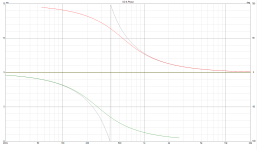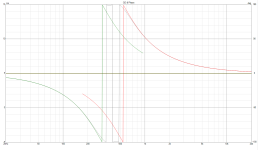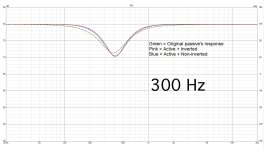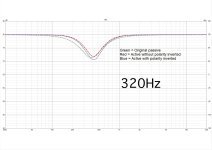I'm working on a project to convert a passive two-pole crossover to an active four-pole crossover. I've been having fun with the simulations. It's getting close to the end. I've arrived at the sweet spot. It is a transition point that provides nearly identical frequency response curves between two cases--reversed and unreversed polarity of one driver in active four-pole crossover system. Despite having nearly identical FR curves, their phase plots differ. Nonetheless, it begs the question of whether these two cases will produce the same sound that we would hear. In brief, if the FR curves match but the phase curves do not, will we be able to tell the difference between the two cases? Also, this creates a tough decision, so which case do you believe is superior?
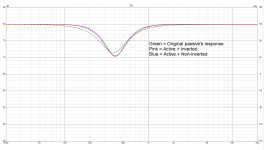

Last edited:
It depends on how extreme the phase growth is......In brief, if the FR curves match but the phase curves do not, will we be able to tell the difference between the two cases?...
If one crossover has less than 90 degrees of total phase shift (i.e., essentially first order IIR filters) and one has significantly more than 90 degrees of phase shift, you will hear a difference if your loudspeakers have full range directivity and you've treated your listening room with absorption to suppress early reflections just around the loudspeakers and the listening position(s).
If however you're talking about the difference between something like 360 degrees and 450 degrees of total phase shift and you're listening on-axis, your loudspeakers are direct radiating (i.e., have essentially no directivity control outside of the highest frequencies of each driver/way) and you have a lot of early reflections just around the loudspeakers and/or the listening position(s), I don't believe that you're going to hear much difference, if any, if the amplitude response is within about ±1.5 dB.
Did I miss the phase plots?Also, this creates a tough decision, so which case do you believe is superior?
Chris
We can not tell much from that plot.
This is a continuation of this thread - https://www.diyaudio.com/community/...linkwitz-riley-conversion.406811/post-7541310
Reversing polarity where phase is out by 90 degrees produces a similar response, but lobing varies so they're not the same.
This is a continuation of this thread - https://www.diyaudio.com/community/...linkwitz-riley-conversion.406811/post-7541310
Reversing polarity where phase is out by 90 degrees produces a similar response, but lobing varies so they're not the same.
It depends on how extreme the phase growth is...
If one crossover has less than 90 degrees of total phase shift (i.e., essentially first order IIR filters) and one has significantly more than 90 degrees of phase shift, you will hear a difference if your loudspeakers have full range directivity and you've treated your listening room with absorption to suppress early reflections just around the loudspeakers and the listening position(s).
If however you're talking about the difference between something like 360 degrees and 450 degrees of total phase shift and you're listening on-axis, your loudspeakers are direct radiating (i.e., have essentially no directivity control outside of the highest frequencies of each driver/way) and you have a lot of early reflections just around the loudspeakers and/or the listening position(s), I don't believe that you're going to hear much difference, if any, if the amplitude response is within about ±1.5 dB.
Did I miss the phase plots?
Chris
Hi Chris,
No, you didn’t miss the phase plots. I didn’t post them because the experiments I was doing were based on simulations by software only, therefore, there were no FR or phase measurement results.
However, I recognized the phase difference because it’s obvious that the polarity of one driver on one experiment was inverted while the other wasn’t.
If you look at the step response, the closer it is to a perfect loudspeaker step response, generally the better it sounds, although my caveats stated above still apply to being able to hear direct arrival energy over first (or subsequent) reflected energy, e.g.,However, I recognized the phase difference because it’s obvious that the polarity of one driver on one experiment was inverted while the other wasn’t.
Chris
Last edited:
If you adhere to the conditions that I described above (full-range directivity and absorption control of early reflections), you will hear a difference in group delay at ±1-2 ms above 500 Hz and ±4-5 ms between 100-500 Hz, and I've found that phase shifts greater than about 120 degrees (without inverting the polarity of a driver) will be audible. Whether or not your hearing decides that the recordings that you listen to sound better or worse is strictly a matter of your musical tastes (especially if they include things like string orchestra, acoustic guitar, violin, viola, cello, solo female human voice of high quality, etc. recordings with intact phase fidelity).
I have encountered many "audiophiles" that consistently listen to and judge all of their equipment choices upon music that doesn't have any sort of remaining phase fidelity, and are judging the differences on loudspeakers having direct radiating drivers (especially woofers) and plenty of nearfield early reflectors in-room (listening only on-axis, of course)...and declare that they cannot hear any differences between crossovers having almost zero phase shift, or more than 720 degrees of total phase shift, and crossover-induced excess group delays of more than 10 ms above 100 Hz. It's then true, under those conditions.
Is that what you were looking for?
Chris
I have encountered many "audiophiles" that consistently listen to and judge all of their equipment choices upon music that doesn't have any sort of remaining phase fidelity, and are judging the differences on loudspeakers having direct radiating drivers (especially woofers) and plenty of nearfield early reflectors in-room (listening only on-axis, of course)...and declare that they cannot hear any differences between crossovers having almost zero phase shift, or more than 720 degrees of total phase shift, and crossover-induced excess group delays of more than 10 ms above 100 Hz. It's then true, under those conditions.
Is that what you were looking for?
Chris
Last edited:
Just a comment here:
Bass phase shifts and group delay (usually below the frequencies of interest in loudspeakers unless they have integral infrasonic drivers--"subwoofers") are perceived differently. The following is a quote from Toole's book Sound Reproduction (1st Ed,, §18.6.2 "Phase Response—The Low Bass". pg. 420):
Chris
Bass phase shifts and group delay (usually below the frequencies of interest in loudspeakers unless they have integral infrasonic drivers--"subwoofers") are perceived differently. The following is a quote from Toole's book Sound Reproduction (1st Ed,, §18.6.2 "Phase Response—The Low Bass". pg. 420):
Craven and Gerzon (1992) stated that the phase distortion caused by...high-pass response is audible, even if the cutoff frequency is reduced to 5 Hz. They say it causes the bass to lack “tightness” and become “woolly.” Phase equalization of the bass, they say, subjectively extends the effective bass response by the order of half an octave.
Chris
To date, I have had the opportunity to conduct listening tests. I discovered that the two scenarios had different outcomes! Nonetheless, they were distinct from the prior post.
Previously, the low-pass section's cut-off frequency was set to 320Hz, with a slope of 24dB/octave. It was altered to 300Hz with the same slope on this thread. Still, the high-pass was the same at 540Hz @ 24dB/octave in both situations.
According to simulations, 320Hz would provide a "obvious" difference on the FR curve regardless of whether the polarity was reversed or not on either low-pass or high-pass, and it would also be valid when listening. However, there was a mild difference on the FR curve of the 300Hz case. The results exhibited that the 300Hz produced less dip on the FR curve with polarity reversal as oppose to the 320Hz.
And the listening tests verified that the sound in these two circumstances would be more pleasing when their FR curves had a shallower dip. Is there anyone who understands and can explain this?
Previously, the low-pass section's cut-off frequency was set to 320Hz, with a slope of 24dB/octave. It was altered to 300Hz with the same slope on this thread. Still, the high-pass was the same at 540Hz @ 24dB/octave in both situations.
According to simulations, 320Hz would provide a "obvious" difference on the FR curve regardless of whether the polarity was reversed or not on either low-pass or high-pass, and it would also be valid when listening. However, there was a mild difference on the FR curve of the 300Hz case. The results exhibited that the 300Hz produced less dip on the FR curve with polarity reversal as oppose to the 320Hz.
And the listening tests verified that the sound in these two circumstances would be more pleasing when their FR curves had a shallower dip. Is there anyone who understands and can explain this?
Attachments
Meaning that the 320Hz didn’t require polarity reversal, while the 300Hz did.the sound in these two circumstances would be more pleasing when their FR curves had a shallower dip.
- Home
- Loudspeakers
- Multi-Way
- Will these cases produce the same result?
